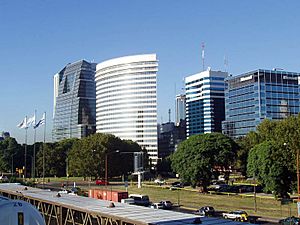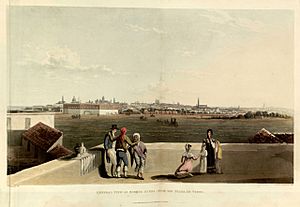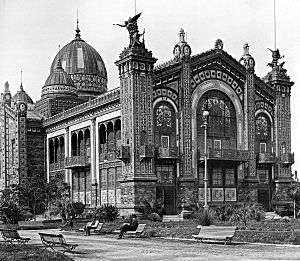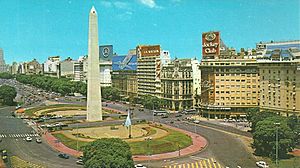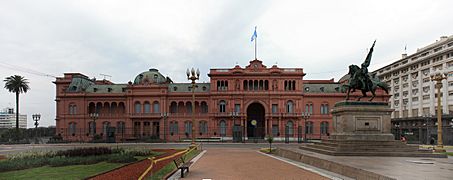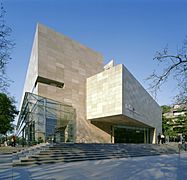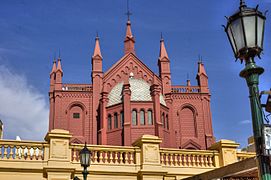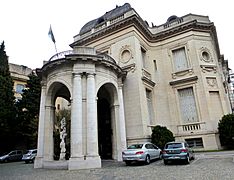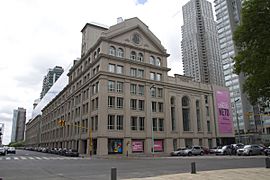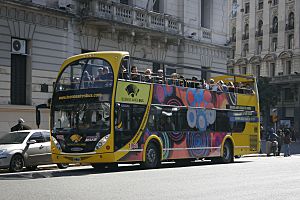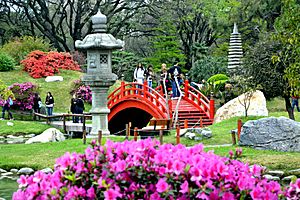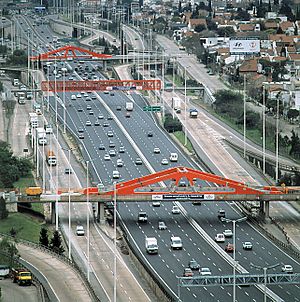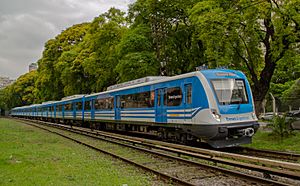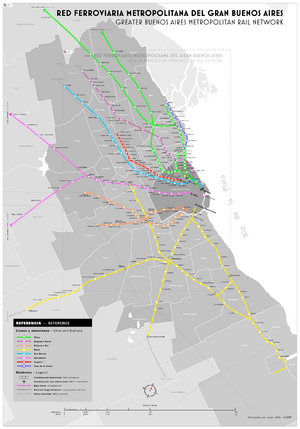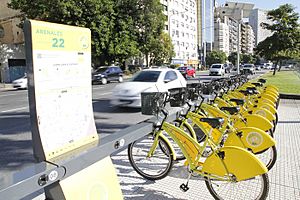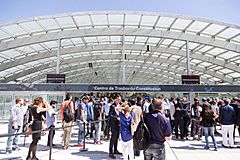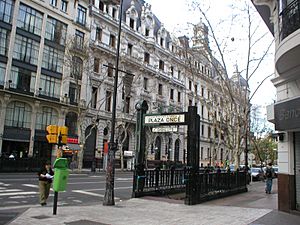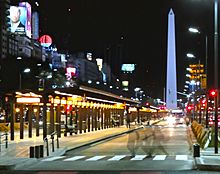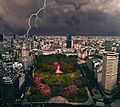Buenos Aires facts for kids
Quick facts for kids
Autonomous City of Buenos Aires
|
|||
|---|---|---|---|
|
Autonomous City
|
|||
| Ciudad Autónoma de Buenos Aires | |||

From top (left to right): skyline of the city at dusk, the National Congress, the Woman's Bridge in Puerto Madero, Tango dancers in San Telmo, the Pink House, the Metropolitan Cathedral, Cabildo, the Obelisk, Colón Theatre, La Recoleta Cemetery, the Planetarium in the Palermo Woods, and Caminito in La Boca.
|
|||
|
|||
| Nickname(s): | |||
| Country | Argentina | ||
| Established | 1536, 1580 | ||
| Government | |||
| • Type | Autonomous city | ||
| Area | |||
| • Autonomous City | 203 km2 (78.5 sq mi) | ||
| • Land | 203 km2 (78.5 sq mi) | ||
| • Metro | 4,758 km2 (1,837 sq mi) | ||
| Elevation | 25 m (82 ft) | ||
| Population
(2010 census.)
|
|||
| • Autonomous City | 2,890,151 | ||
| • Density | 14,240/km2 (36,817/sq mi) | ||
| • Metro | 12,801,364 | ||
| Demonym(s) | porteño (m), porteña (f) | ||
| Time zone | UTC−3 (ART) | ||
| Area code(s) | 011 | ||
| HDI (2010) | 0.953 – Very High | ||
| Website | (Spanish) bue.gov.ar (English) | ||
Buenos Aires is the capital and largest city in the South American country of Argentina. It is also known as Capital Federal to tell it apart from the Buenos Aires Province.
Before 1994, the city was directly controlled by the national government. But after a change in the country's rules, citizens gained the right to choose their own city leaders. This made Buenos Aires a self-governing city.
Contents
History of Buenos Aires
Early Colonial Times
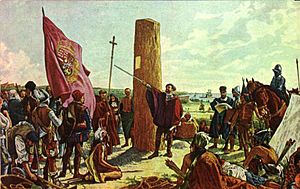
In 1516, the Spanish explorer Juan Díaz de Solís was the first European to reach the Río de la Plata. Sadly, his journey ended when native people attacked and killed him.
The city of Buenos Aires was first started on February 2, 1536. It was named Ciudad de Nuestra Señora Santa María del Buen Ayre, which means "City of Our Lady Saint Mary of the Fair Winds." This first settlement was led by Pedro de Mendoza. It was located where the San Telmo area is today, south of the city center.
However, attacks from native groups forced the settlers to leave. The site was abandoned in 1542. A second, lasting settlement was then created on June 11, 1580, by Juan de Garay. He sailed down the Paraná River from Asunción (now the capital of Paraguay). He called the new settlement "Santísima Trinidad." Its port was named "Puerto de Santa María de los Buenos Aires."
From the start, Buenos Aires relied on trade. For much of the 1600s and 1700s, Spanish ships faced pirate threats. So, Spain created a complex trade route. Goods went from Spain to Central America, then overland to Lima, Peru, and finally to other cities. This made products arrive very slowly in Buenos Aires and cost a lot due to taxes. This system made traders in Buenos Aires unhappy. Many started illegal trading, which made them dislike the Spanish rulers even more.
Steps Towards Independence
King Charles III of Spain saw the growing unhappiness. He slowly reduced trade rules and made Buenos Aires an open port in the late 1700s. He also created the Viceroyalty of the Río de la Plata, with Buenos Aires as its capital. This was meant to calm the people. But it didn't work. Many porteños (people from Buenos Aires) were inspired by the French Revolution. They became even more sure that they needed to be free from Spain.
During the British invasions, British forces attacked Buenos Aires twice. In 1806, the British took over the city. But an army from Montevideo, led by Santiago de Liniers, defeated them. Buenos Aires became the capital again after it was freed. Liniers then prepared the city and stopped another British attack in 1807.
The city's people, especially the criollos (people of Spanish descent born in the Americas), gained more power. By 1810, these groups supported a new revolution. They successfully removed the Spanish ruler. This event is known as the May Revolution. It is now a national holiday. This started the Argentine War of Independence. Armies from Buenos Aires fought against Spanish loyalists. Argentina officially declared its independence from Spain in 1816. Buenos Aires remained free throughout the war.

Historically, Buenos Aires has been a center for new ideas, trade, and foreign influences. Many other provinces, especially in the northwest, preferred a more traditional and Catholic way of life. This difference caused much tension in Argentina's history. After the May Revolution, Buenos Aires sent military groups to the provinces to get their support. Many of these missions led to fights, increasing the tension between the capital and the provinces.
In the 1800s, naval forces blocked the city twice. The French blocked it from 1838 to 1840. Then, an Anglo-French group blocked it from 1845 to 1848. Both blockades failed to make the city surrender.
19th and 20th Century Growth
For most of the 1800s, the city's political status was a big debate. It was the capital of Buenos Aires Province. From 1853 to 1860, it was the capital of the separate State of Buenos Aires. This issue was even fought over in battles. Finally, in 1880, the city became a federal district. This meant it was the seat of the national government. The president appointed its mayor. The Casa Rosada became the president's office.
Health conditions in poor areas were bad, with many cases of tuberculosis. Doctors and politicians often blamed the poor and their crowded homes for the disease. People sometimes ignored health campaigns, like rules against spitting or strict baby care guidelines.
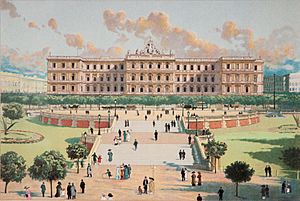
The city grew rich from its customs duties and the fertile pampas lands. Also, railroad development in the late 1800s boosted Buenos Aires' economy. Raw materials flowed into its factories. From 1880 to 1930, many immigrants, especially from Italy and Spain, came to Buenos Aires. It became a diverse city, similar to major European capitals. The Teatro Colón became a top opera house. The city became a center for radio, television, movies, and theater.
Major avenues were built during these years. In the early 1900s, South America's tallest buildings and its first subway system were constructed. Another building boom from 1945 to 1980 changed the city center and much of the city.

Buenos Aires also attracted people from other parts of Argentina and nearby countries. Poor neighborhoods called villas miseria grew around the city's industrial areas in the 1930s. This led to social problems and big differences between rich and poor. These workers became the main supporters of Peronism. This political movement started in Buenos Aires on October 17, 1945, at the Plaza de Mayo. Industrial workers in the Greater Buenos Aires area have been Peronism's main support ever since. Plaza de Mayo became a place for protests and many political events. However, on June 16, 1955, a part of the Navy bombed the Plaza de Mayo area, killing many civilians. This was the only time the city was attacked from the air. A military uprising followed, removing President Perón three months later.
Buenos Aires in the 21st Century
In 1996, after the 1994 change to the Argentine Constitution, the city held its first mayoral elections under new rules. The mayor's title was officially changed to "Head of Government." Fernando de la Rúa won and later became President of Argentina.
His successor, Aníbal Ibarra, won two elections. But he was removed from office in 2006 after a tragic nightclub fire. Jorge Telerman then became the acting mayor. In the 2007 elections, Mauricio Macri won and took office. He was re-elected in 2011.
The 2015 elections were the first to use an electronic voting system in the city. Horacio Rodríguez Larreta became the mayoral candidate for his party. He won the election in a second round of voting, continuing his party's leadership in the city.
Geography of Buenos Aires
The city of Buenos Aires is located in the pampa region. Some areas, like the Buenos Aires Ecological Reserve and Puerto Madero, were built on land reclaimed from the Río de la Plata (the world's widest river).
The area used to have many streams and lagoons. Some were filled in, and others were put into underground pipes. Important streams include Maldonado, Vega, Medrano, Cildañez, and White. In 1908, many streams were straightened and channeled because floods were damaging the city. By 1919, most streams were enclosed. For example, the Maldonado stream was put into a pipe in 1954 and now runs under Juan B. Justo Avenue.

Buenos Aires Climate
Buenos Aires has a humid subtropical climate with four clear seasons. The nearby Atlantic Ocean keeps the weather mild, so extreme temperatures are rare. The city's weather can change quickly because of the Pampero and Sudestada winds.
Summers are hot and humid. January is the warmest month, with an average daily temperature of 24.9°C (76.8°F). Heat waves are common but usually short. They are often followed by the cold, dry Pampero wind, which brings strong thunderstorms and cooler weather. The highest temperature ever recorded was 43.3°C (109.9°F) on January 29, 1957.
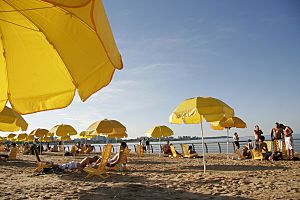
Winters are cool with mild days and cold nights. Highs average 16.3°C (61.3°F), and lows average 8.1°C (46.6°F). High humidity often causes moderate to heavy fogs in autumn and winter. July is the coolest month, with an average temperature of 11.0°C (51.8°F). Cold air from Antarctica arrives almost every year, lasting for several days. Sometimes, warm air from the north brings higher temperatures. The lowest temperature ever recorded in central Buenos Aires was -5.4°C (22.3°F) on July 9, 1918. Snow is very rare. The last snowfall happened on July 9, 2007. This was the first major snowfall in the city in 89 years.
Spring and autumn have changeable weather. Cold air from the south can bring cooler temperatures, while hot, humid air from the north brings warmer weather.
The city gets about 1236.3 mm (48.67 inches) of rain each year. Because of its flat land and old drainage system, the city can flood during heavy rains.
| Climate data for Buenos Aires Central Observatory, located in Villa Ortúzar (1981–2010) | |||||||||||||
|---|---|---|---|---|---|---|---|---|---|---|---|---|---|
| Month | Jan | Feb | Mar | Apr | May | Jun | Jul | Aug | Sep | Oct | Nov | Dec | Year |
| Mean daily maximum °C (°F) | 30.1 (86.2) |
28.6 (83.5) |
26.8 (80.2) |
22.9 (73.2) |
19.3 (66.7) |
16.0 (60.8) |
15.4 (59.7) |
17.7 (63.9) |
19.3 (66.7) |
22.6 (72.7) |
25.6 (78.1) |
28.5 (83.3) |
22.7 (72.9) |
| Daily mean °C (°F) | 24.9 (76.8) |
23.6 (74.5) |
21.9 (71.4) |
17.9 (64.2) |
14.5 (58.1) |
11.7 (53.1) |
11.0 (51.8) |
12.8 (55.0) |
14.6 (58.3) |
17.8 (64.0) |
20.7 (69.3) |
23.3 (73.9) |
17.9 (64.2) |
| Mean daily minimum °C (°F) | 20.1 (68.2) |
19.3 (66.7) |
17.7 (63.9) |
13.8 (56.8) |
10.7 (51.3) |
8.0 (46.4) |
7.4 (45.3) |
8.8 (47.8) |
10.3 (50.5) |
13.3 (55.9) |
15.9 (60.6) |
18.4 (65.1) |
13.6 (56.5) |
| Average precipitation mm (inches) | 138.8 (5.46) |
127.1 (5.00) |
140.1 (5.52) |
119.0 (4.69) |
92.3 (3.63) |
58.8 (2.31) |
60.6 (2.39) |
64.2 (2.53) |
72.0 (2.83) |
127.2 (5.01) |
117.3 (4.62) |
118.9 (4.68) |
1,236.3 (48.67) |
| Average precipitation days (≥ 0.1 mm) | 9 | 8 | 9 | 9 | 7 | 7 | 7 | 7 | 7 | 10 | 10 | 9 | 99 |
| Mean monthly sunshine hours | 279.0 | 240.8 | 229.0 | 220.0 | 173.6 | 132.0 | 142.6 | 173.6 | 189.0 | 227.0 | 252.0 | 266.6 | 2,525.2 |
| Source 1: Servicio Meteorológico Nacional | |||||||||||||
| Source 2: Deutscher Wetterdienst (sun, 1961–1990) | |||||||||||||
Government and How Buenos Aires is Run
How the City Government Works
The city's leader is called the Chief of Government. This person is elected for a four-year term, along with a Deputy Chief. The Deputy Chief leads the 60-member Buenos Aires City Legislature. Half of the Legislature's members are elected every two years, and they also serve four-year terms. Elections use a system that makes sure different groups are fairly represented.
The city also has a Judicial branch, which includes the Supreme Court of Justice and other city courts. The city's constitution says that voting is free, equal, secret, and required for citizens. People who live in the city but are not citizens can also vote, with the same rights and duties as Argentine citizens.
-
Casa Rosada, where the President of Argentina works, is in the Monserrat neighborhood.
-
The Palace of Justice of the Argentine Nation is in the San Nicolás, Buenos Aires neighborhood.
People and Culture of Buenos Aires
Who Lives in Buenos Aires?
The number of people living in Buenos Aires city has been around 3 million since 1947. This is because fewer babies are being born, and people are slowly moving to the suburbs. However, the areas around the city have grown a lot, with about 10 million people living there now.
A 2001 study showed that Buenos Aires has an older population. About 17% of people were under 15, and 22% were over 60. This is similar to many European cities. In Argentina as a whole, more people are under 15 (28%) and fewer are over 60 (14%).
Two-thirds of the city's residents live in apartment buildings. About 30% live in single-family homes. A small number (4%) live in very basic housing. In 2007, about 8.4% of the city's residents lived below the poverty line. When including the wider metro area, this number was 20.6%.
Buenos Aires Culture
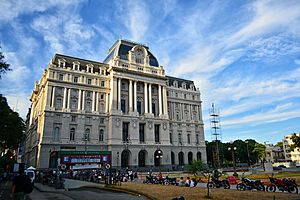
Buenos Aires is strongly influenced by European culture. It is sometimes called the "Paris of South America." The city has the busiest live theater scene in Latin America. Every weekend, about 300 theaters are active, which is more than London, New York, or Paris. The city also ranks second worldwide for cultural festivals with many locations and a long history. The Kirchner Cultural Centre in Buenos Aires is the largest in Latin America and the third largest globally.
Buenos Aires is home to the Teatro Colón, a world-famous opera house. There are several symphony orchestras and choirs. The city has many museums about history, fine arts, modern arts, and more. It also has preserved homes of famous artists and writers. Buenos Aires is known for its hundreds of bookstores, public libraries, and cultural groups, earning it the nickname "the city of books." It has a famous zoo and botanical garden, many parks, and beautiful churches.
Art Scene in Buenos Aires
Buenos Aires has a lively art culture with many museums. The neighborhoods of Palermo and Recoleta are traditional art centers. But recently, new art spaces have opened in areas like Puerto Madero and La Boca. Famous places to see art include MALBA, the National Museum of Fine Arts, and the Faena Arts Center.
Other popular museums are the Buenos Aires Museum of Modern Art and the Evita Museum. A special event each year is La Noche de los Museos ("Night of the Museums"). During this night, the city's museums and art spaces open for free until early morning. It usually happens in November.
Buenos Aires has been the birthplace of many important artists and art styles. The city itself has often been a theme in Argentine art, especially since the 1900s. Examples include the Paris Group, influenced by European art, and the La Boca artists, who often painted scenes from their working-class port neighborhood. In the 1960s, the Torcuato di Tella Institute became a key center for new art forms like pop art and experimental theatre.
Language Spoken in Buenos Aires
The Spanish spoken in Buenos Aires is called Rioplatense Spanish. It has special features like using "vos" instead of "tú" and a distinct pronunciation of "ll" and "y." It is also influenced by Spanish dialects from Andalusia and Murcia in Spain.
In the early 1900s, millions of immigrants came to Argentina, many from Italy. They spoke different Italian dialects. As they learned Spanish, they created a mix of Italian and Spanish called cocoliche. This mix was less common by the 1950s. A study showed that the way porteños (people from Buenos Aires) speak sounds more like Neapolitan Italian than other Spanish dialects.
Many Spanish immigrants were from Galicia. Even today, Spaniards are often called gallegos (Galicians) in Argentina. Galician language, food, and culture were very present in the city for much of the 20th century. Recently, descendants of Galician immigrants have helped bring back Celtic music.
Lunfardo is a special slang that started in prisons and later spread to all porteños. It uses words from Italian, Brazilian Portuguese, African, and Caribbean languages, and even English. Lunfardo often plays with words by reversing syllables. Today, you mostly hear Lunfardo in tango songs. Younger generations use different slang.
Music and Dance
According to the Harvard Dictionary of Music, Argentina has a very rich tradition of classical music. Buenos Aires has several professional orchestras and music schools. In the late 1700s, theaters became very important for music in Argentina, showing Italian and French operas. Italian music was very popular in the 1800s and early 1900s, partly because of immigration. Argentine composers also wrote operas and salon music. Later, composers started using Argentine traditions and folk music in their works. In the 1930s, composers began to use more modern styles, influenced by new techniques. By the 1960s, avant-garde music was popular, with new music centers and electronic music studios.
The Río de la Plata region is famous as the birthplace of tango. Tango is seen as a symbol of Buenos Aires. The city calls itself the Tango World Capital. It hosts many tango events, including an annual festival and world tournament. The most famous tango artist is Carlos Gardel. Other important composers include Ástor Piazzolla and Mariano Mores. Tango music was very popular in the 1940s. In the 1960s and 1970s, a new style called nuevo tango appeared, mixing classical and jazz music. Today, there's also neotango (or electrotango), with groups like Bajofondo. In 2009, UNESCO declared tango a part of the world's cultural heritage.
The city hosts several music festivals each year. Popular electronic dance music festivals include Creamfields BA and Moonpark. Other well-known events are the Buenos Aires Jazz Festival and Quilmes Rock. Some music festivals, like Lollapalooza, are held just outside Buenos Aires.
Cityscape and Architecture
Buenos Aires Architecture
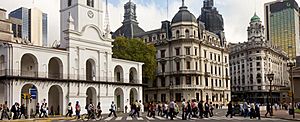
Buenos Aires architecture is a mix of many styles, like those found in Paris and Madrid. Because of immigration, you can see Colonial, Art Deco, Art Nouveau, Neo-Gothic, and French styles. Italian and French influences grew after Argentina became independent in the early 1800s.
Many buildings were updated in the late 1800s and early 1900s, showing European influences. Examples include the Iglesia Santa Felicitas and the National Congress. The Teatro Colón is another example of this period.
The simple Rioplatense baroque style is clear in Buenos Aires. You can see it in churches like San Ignacio and Our Lady of the Pillar, as well as the Cathedral and the Cabildo.
In 1912, the Basilica del Santisimo Sacramento opened. It was built with a generous gift and is a great example of French neo-classicism. It has beautiful decorations inside, including a huge organ. The altar is made of marble and was the largest in South America at the time.
Construction of Palacio Barolo began in 1919. It was South America's tallest building then and the first Argentine skyscraper made of concrete (1919–1923). The building had 9 elevators and a large lobby with paintings. A powerful light was installed at the top, visible even from Uruguay. In 2009, the Barolo Palace was restored, and the light was turned on again.
In 1936, the Kavanagh building opened. It was 120 meters (394 feet) tall and had 12 elevators. It also had the world's first central air-conditioning system. It is still an important building in Buenos Aires.
In the second half of the 20th century, buildings continued to copy French styles, like the Banco de la Nación Argentina headquarters. However, since the 1930s, the ideas of Le Corbusier and European rationalism became popular. Many skyscrapers were built in Buenos Aires until the 1950s. Newer modern buildings by Argentine architects in recent years include the Le Parc Tower and the Repsol-YPF tower.
Tourism in Buenos Aires
Tourism has been growing in Buenos Aires since 2002. In 2008, a travel magazine called Buenos Aires the second most desired city to visit after Florence, Italy. That year, about 2.5 million visitors came to the city.
The most popular tourist spots are in the historic center. This includes the Montserrat and San Telmo neighborhoods. Buenos Aires was planned around the Plaza de Mayo, which was the main administrative center during colonial times. East of the square is the Casa Rosada, where the president works. To the north is the Catedral Metropolitana, which has been there since colonial times. Other important old buildings include the Cabildo and the City Hall.
Parks and Green Spaces
Buenos Aires has over 250 parks and green spaces. Most of them are on the city’s eastern side in the Puerto Madero, Recoleta, Palermo, and Belgrano neighborhoods. Some of the most important parks are:
- Parque Tres de Febrero: This park opened in 1875. It was later expanded and beautified by Carlos Thays between 1892 and 1912. Thays also designed the Zoological Gardens, the Botanical Gardens, and the Rose Garden.
- Botanical Gardens: Designed by French architect Carlos Thays, this garden opened in 1898. Thays and his family lived in a mansion within the gardens.
- Buenos Aires Japanese Gardens: This is the largest Japanese garden outside Japan. It was completed in 1967.
- Plaza de Mayo: This square has been a center of political life in Argentina since the May Revolution in 1810, which led to independence.
- Plaza San Martín: This park is in the Retiro neighborhood. It is at the north end of the pedestrian Florida Street.
Famous Landmarks

- Cabildo: This building was the government house during the colonial times. The original building was finished in 1610. It has been changed many times over the years. In 1940, an architect rebuilt its colonial look using old documents.
- Kavanagh building: Located at 1065 Florida St. in the Retiro neighborhood, this building overlooks Plaza San Martín. It was built in the 1930s and finished in 1936. It is known for its simple design and lack of outside decorations. Standing at 120 meters (394 feet), it is still an impressive building. It was named a national historical monument in 1999.
- Metropolitan Cathedral: This is the main Catholic church in Buenos Aires. It is in the city center, facing Plaza de Mayo. It has been in the same spot since colonial times.
- National Library: This is the largest library in Argentina and one of the most important in the Americas.
- The Obelisk: This monument was built in May 1936 to celebrate the city's 400th anniversary. It is in the middle of the Plaza de la República. This is where the Argentine flag was first flown in Buenos Aires. It is 67 meters (220 feet) tall. It was designed by architect Alberto Prebisch and built in just four weeks.
- The Water Company Palace: This building is perhaps the world's most decorated water pumping station.
Getting Around Buenos Aires
Airports for Travel
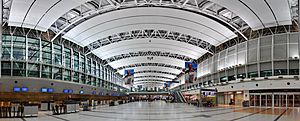
The main international airport for Buenos Aires is Ministro Pistarini International Airport. It is located in the suburb of Ezeiza. People often call it the "Ezeiza International Airport." The Aeroparque Jorge Newbery airport is in the Palermo area, next to the river. It handles flights within Argentina and to nearby countries like Brazil and Chile. A smaller airport, San Fernando Airport, is only for private planes.
City Roads and Getting Around by Car
Buenos Aires is mostly laid out in a square grid pattern. This creates square blocks called manzanas, each about 110 meters (360 feet) long. In the city center, pedestrian areas like Florida Street are car-free and always busy. You can reach them by bus or subway. Buenos Aires is easy to walk around, and most residents use public transport.
Two diagonal avenues in the city center help with traffic and make it easier to reach Plaza de Mayo. Most main avenues going into and out of the city center are one-way. They have six or more lanes and use special traffic light systems to keep traffic moving smoothly.
The city's main avenues include the 140-meter (460-foot) wide July 9 Avenue. There is also the over 35-kilometer (22-mile) long Rivadavia Avenue. Corrientes Avenue is a main street for culture and entertainment.
In the 1940s and 1950s, the General Paz Avenue beltway was built around the city. New highways also led to the international airport and northern suburbs. This changed traffic in Buenos Aires. Car sales grew a lot from the 1970s onwards. Today, over 1.8 million vehicles are registered in Buenos Aires.
Toll motorways opened in the late 1970s. They provide fast access to the city center and are used by over a million vehicles daily. The city also closed some financial district streets to private cars during the day. However, most major avenues still get very crowded during busy hours.
Public Transport in the City
Commuter Trains
The Buenos Aires commuter train system is very large. More than 1.3 million people travel to the capital every day. These trains run from 4 AM to 1 AM. The train network also connects the city to other major areas like Rosario and Córdoba. There are four main terminals in the city center for both long-distance and local trains: Constitucion, Retiro, Federico Lacroze, and Once.
Most commuter trains are run by the state-owned Trenes Argentinos. However, some lines are operated by private companies. All services used to be private, but after several accidents, they were put back under state control.
Since 2013, there have been big investments in the train network. Most lines have received new trains. There have also been many improvements to the tracks and stations. Almost all level crossings (where roads cross train tracks) in the city have been replaced with underpasses or overpasses. One major project is to electrify and move a large part of the Sarmiento Line underground in the city center. This will allow trains to run more often and reduce traffic above ground.
There are also plans for three other big projects. One would raise a large part of the San Martín Line and electrify it. Another would electrify and extend the Belgrano Sur Line. The third and most ambitious plan is to build underground tunnels connecting three of the city's train terminals. This network, called the Red de Expresos Regionales, would have a large underground central station.
Bicycles
In December 2010, the city started a bike-sharing program. You can rent bicycles for free after you register. There are 31 rental stations, mostly in central areas. They offer over 850 bicycles that can be picked up and dropped off at any station within an hour. As of 2013, the city has built 110 km (68 miles) of protected bike lanes. There are plans to build another 100 km (62 miles). In 2015, the stations became automated, and the service became available 24 hours a day using a smart card or phone app.
Subway System
The Buenos Aires Underground (known as subte) is a system that helps people get to different parts of the city. It opened in 1913, making it the oldest subway system in the Southern Hemisphere and the Spanish-speaking world. The system has six underground lines (A to E, and H) and one overground line. There are 100 stations and 58.8 km (36.5 miles) of routes, including the Premetro line. The city is working to extend existing lines and add a new north-south line.
Line A is the oldest, opening in 1913. Its stations still have their old decorations. The original trains from 1913, called Las Brujas, were retired in 2013. About 1.7 million people use the subway on weekdays, and this number is growing. Fares are still quite cheap.
Recent additions to the network in 2013 include new stations on Line A, Line B, and Line H. Current work includes finishing Line H to the north and adding three new stations to Line E. Construction of Line F is planned to start soon, and two more lines are planned for the future.
Tramways
Buenos Aires used to have a large street railway (tram) system with over 857 km (533 miles) of track. This system was removed in the 1960s in favor of buses. However, surface rail transport has made a small return in some parts of the city. The PreMetro is a 7.4 km (4.6 miles) light rail line. It connects with Underground Line E and runs to other areas. It opened in 1987.
A 2 km (1.2 miles) modern tramway, the Tranvía del Este, opened in 2007 in the Puerto Madero area. However, plans to extend the line did not happen, and it closed in 2012. A heritage streetcar run by tram fans operates on weekends near the Primera Junta subway station.
Buses
There are over 150 city bus lines, called Colectivos. Each is run by a different company. They compete with each other and are used by many people. Buses run very often, sometimes several times an hour. They cover a much wider area than the subway system. Buses in Buenos Aires do not have a fixed timetable. With cheap tickets and many routes, the colectivo is the most popular way to get around the city.
Buenos Aires recently opened a bus rapid transit system called the Metrobus. This system uses special stations in the middle of the road. The first line opened in 2011. The system now has 4 lines with 113 stations. Many more lines are being built or planned.
Taxis
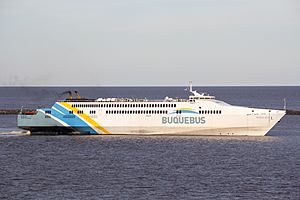
About 40,000 black-and-yellow taxis operate in the city at all hours. Sometimes, there are reports of problems with taxis at airports. Taxi drivers are known for sometimes trying to overcharge tourists. Radio-link taxi companies offer reliable and safe service. Cheaper car services, called remises, have also become popular.
Ferries
Buenos Aires also has a ferry system run by the company Buquebus. It connects the port of Buenos Aires with major cities in Uruguay, like Colonia del Sacramento, Montevideo, and Punta del Este. More than 2.2 million people travel between Argentina and Uruguay by ferry each year. Some of these ships are very fast catamarans.
Public Transportation Statistics
According to data from July 2017, people in Buenos Aires spend an average of 79 minutes commuting by public transit on a weekday. About 23% of riders travel for more than 2 hours each day. People wait at a stop or station for about 14 minutes on average. About 20% wait for over 20 minutes daily. The average distance people travel in one trip by public transit is 8.9 km (5.5 miles). About 21% travel more than 12 km (7.5 miles) in a single direction.
| Provinces of Argentina | |
|---|---|
| Buenos Aires | Buenos Aires Province | Catamarca | Chaco | Chubut | Córdoba | Corrientes | Entre Ríos | Formosa | Jujuy | La Pampa | La Rioja | Mendoza | Misiones | Neuquen | Río Negro | Salta | San Juan | San Luis | Santa Cruz | Santa Fe | Santiago del Estero | Tierra del Fuego, Antarctica, and South Atlantic Islands | Tucumán | |
Images for kids
-
Construction of the Obelisk of Buenos Aires on the 9 de Julio Avenue, 1936.
-
The Metropolitan Cathedral is the main Catholic church in the city.
-
Monument to the Carta Magna and Four Regions of Argentina in the neighborhood of Palermo.
-
Homage to Buenos Aires, a mural at the Carlos Gardel station of the Buenos Aires Underground. It shows a typical city scene and icons like singer Carlos Gardel, the Obelisco, the port, tango dancing, and the Abasto market.
-
University of Buenos Aires' Law School in Recoleta.
-
La Bombonera during a night game of Copa Libertadores between Boca Juniors and Colo Colo.
See also
 In Spanish: Buenos Aires para niños
In Spanish: Buenos Aires para niños




